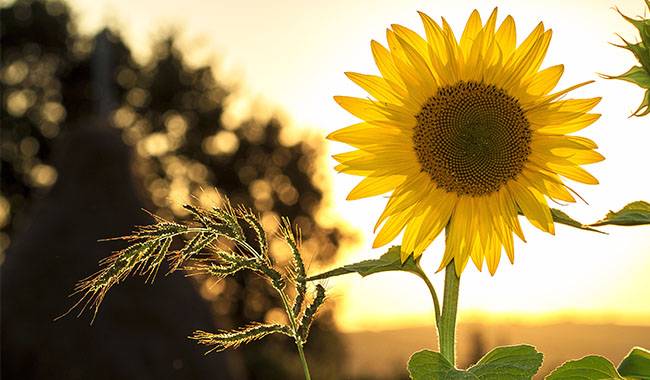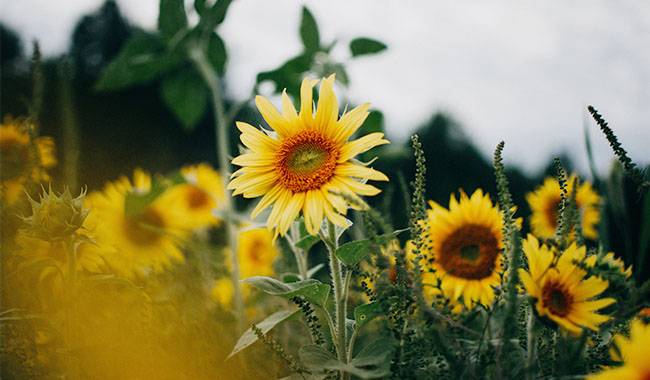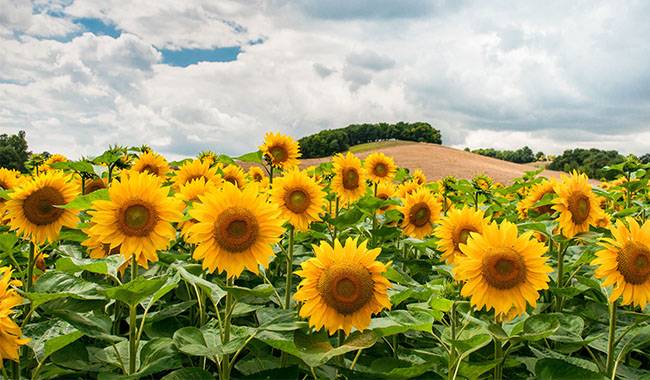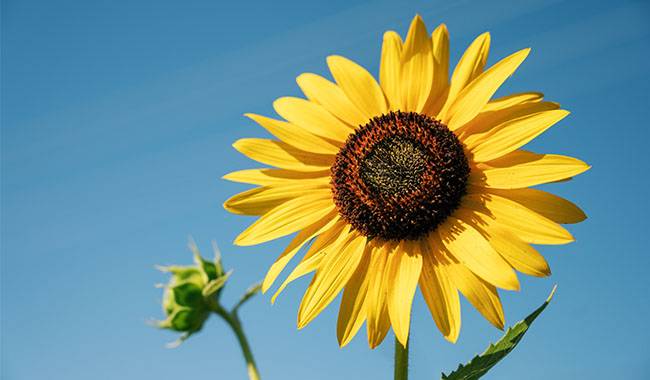
How to grow a giant sunflower? Most people associate the word “sunflower” with cheerful, bright baskets that follow the sun and delicious roasted seeds.
But sunflowers are a unique plant, and there are many varieties that can impress through their taste, decorative qualities, and even size. For example, in 2005 a giant sunflower plant grew in the village of Spasskoye, standing 15 feet (4.5 meters) tall!
Its leaves reached a length of 24inch (60 cm), the trunk had a diameter of 4.8inch (12 cm), and a basket of 18inch (47 cm). Such a huge sunflower is no accident! Giant sunflowers are a breeding trend for this crop.
About the astonishingly huge size of sunflower varieties, I will tell you about their agronomic techniques in the article.
SUNFLOWER IN THE GUINNESS BOOK OF RECORDS
To be precise, the “Miracle of Spaska” has not been recorded in sunflowers. The real sunflower record is registered in the Guinness Book at 30foot (9m 14cm) tall!
This giant was planted in the not-so-distant year 2014 by Hans-Peter Schiffer, an ordinary German amateur gardener living in the town of Kast. And this is already his third record! And it all started at eight meters high.
When asked how to grow such a sunflower plant, Hans admits that it wasn’t easy. Giant plants need good nutrition, loose soil, constant irrigation (especially to keep the deep roots hydrated), and open sunlight.
But on top of that, in the area where the gardener’s plot is located, thunderstorms and hail often fall, destroying almost all of the foliage on the plants. Also, the huge sunflowers, in order not to fall down, must be supported by a multi-layered frame.
By the way, the largest sunflower in the basket – 32inch (82 cm) in diameter – is grown in Canada. The world’s tiniest sunflower, on the other hand, was presented by flower growers in Oregon. Its height is only 2inch (5cm). It is grown in a bonsai style.
VARIETIES OF LARGE SUNFLOWERS
Most of us don’t need nine-meter monster sunflowers in our neighborhoods. However, sometimes it’s fun to plant something unusual in order to surprise your loved ones. And it is possible! Because today you can buy anything, even seeds of giant varieties of sunflowers. And every year they have a wider and wider selection.
For example, the famous variety “Tarahumara” grows up to 13 feet (4 meters) tall, with a large flower basket, up to 20inch (50 cm) in diameter, and large, white seeds.
The bear-square sunflower grows to 10-13foot (3-4 meters) tall, has a basket 10-12inch (25-30 cm) in diameter, and large, white, slightly curved seeds, hence the name.
Sunflower variety ‘Mammoth’ is 13 feet (4 meters) tall, with a basket diameter of 16inch (40 cm) and thick, white seeds.
The ‘Titan’ variety forms plant up to 13foot (4 m) tall, 12-28inch (30 to 70 cm) in size, with large seeds, about 0.8inch (2 cm) long, and gray striped.
Gorgonians can be taller, up to 16foot (5 m), with flower heads 10inch (25 cm) in diameter.
Mongolian Giant, up to 16foot (5m) tall, head diameter 18inch (45cm), seeds 1-1.4inch (2.5-3.5cm).
Exhibition Giant and Giant White Seed Sunflower, growing to over 10foot (3m) tall, are also tall in stature.
SOWING SEEDS
When buying Giant varieties, you need to understand that, like other varieties, these varieties will perform differently in different soils and conditions. No, they will not dwarf by any means, but in order to allow the full potential to unfold, you need to try.
When planting, choose the sunniest, most fertile spot, make sure the soil is well aerated, away from weeds, and water regularly.
With insufficient light, sunflowers are less developed, form smaller baskets, and yield significantly less.
Seeds are best planted immediately in the open, as the culture is poorly tolerant of transplanting. However, if the summer is very short, you can apply and germination method, but do not delay with permanent place planting. It is already necessary to transplant sunflowers into the garden 20-25 days after germination.
Cups of seedlings are best taken deep, about 12inch (30 cm) in height. A depth of 1.2-1.6inch (3-4 cm) is appropriate for embedding the seeds. The seedlings should be hardened before planting in the open ground. To increase the rearing area, it is best to leave a large distance between plants, at least 3.2foot (1 meter).
For seeds sown immediately into permanent locations, soil temperatures should reach 50°F (10°C). The crop will not be affected by frost rejuvenation. Sunflowers can tolerate short-term temperature drops to 23°F (-5°C) at stages of up to four pairs of leaves.
SUNFLOWERS AND CROP ROTATION
The place is best chosen as a new one, where no sunflower has been grown before, or at least 3-4, preferably 5-9 years ago, always thinking of the predecessors.
The main principle in the selection of predecessors must be the absence of diseases common to sunflowers, in particular, all crops that can affect mosaic, sulfur, and white rot must be excluded from the crop rotation.
It is not recommended to plant sunflower after different types of cruciferous crops such as cabbage, radish, daikon, and mustard. Also after legumes – peas, beans, lentils, chickpeas, pulses, soybeans. After other oilseeds and potatoes. In addition, careful tillage to loosen the soil and thin planting will help prevent diseases.
In addition to general diseases, the incompatibility of sunflower with plants such as cabbage, broadleaf aster, and oilseed rape can be explained by the negative effect of allelopathy, whereby the plants produce root excreta that inhibit the growth and development of other plants.

BROOMRAPE IS A NATURAL ENEMY OF SUNFLOWER
Another problem in crop cultivation is considered to be an insect pest, a parasitic plant that germinates on sunflower roots and deprives them of nutrients and water.
As a result, sunflower plants do not grow easily, become dull, produce smaller baskets, shrivel seeds, have poor seed quality, and have a low unsaturated fat content. In addition, infested crops are more susceptible to diseases, which combine to reduce yields by 35-70%.
In order to avoid infestations, the following conditions must be observed.
- planting cultures in the same location at intervals of at least 5-9 years; digging the soil deep with a joint turnover depth of 12-14inch (30-35 cm) before sowing sunflower; it can be dug out by simultaneous application of fertilizer in the fall.
- system of weeding with a broom to prevent plants from forming seeds.
- observation of spatial segregation of current and last year’s planted soil, and liming of acidic soil.
CARE OF LARGE SUNFLOWERS
Sunflower is considered to be a less responsive crop when it comes to fertilization. However, in order to get the highest plants, everyone who wants to win mentions the increased application of organic matter. For example, Richard Hope, a gardener from England who grows sunflowers up to 26foot (7.9 meters) in height, told reporters that he spent 15 bags of fertilizer for this result.
If your aim is not competition, but simply a good harvest, it is enough to apply 1-2 kg of well-rotted fertilizer per square meter under autumn digging.
In order to obtain high results, it is very important to monitor the presence of weeds, to which sunflower is particularly sensitive in the early stages of its development – the first 30-40 days. Weeding is also a way to prevent damage to the culture by pests.
Sunflower has a well-developed root system. On the one hand, it can extract water from the deep soil up to 6.5-10 feet (2-3 meters). On the other hand, it requires soil that is loose and soft. However, the water requirements are different at different stages of plant development. The highest requirements are during flowering and seed maturity. During the rest of the year, the plant does not require heavy watering.
Sunflower is very strong on dry soil. After its planting, it takes 3 years to restore the water supply. Therefore, it is recommended to plant crops with shallow root systems after sunflowers to extract water from the upper layers of the soil.
Sunflowers are harvested in September. It is easy to tell when the time is right by the appearance of the basket: its back has turned yellow, the flowers have begun to fall off and the leaves have withered.





